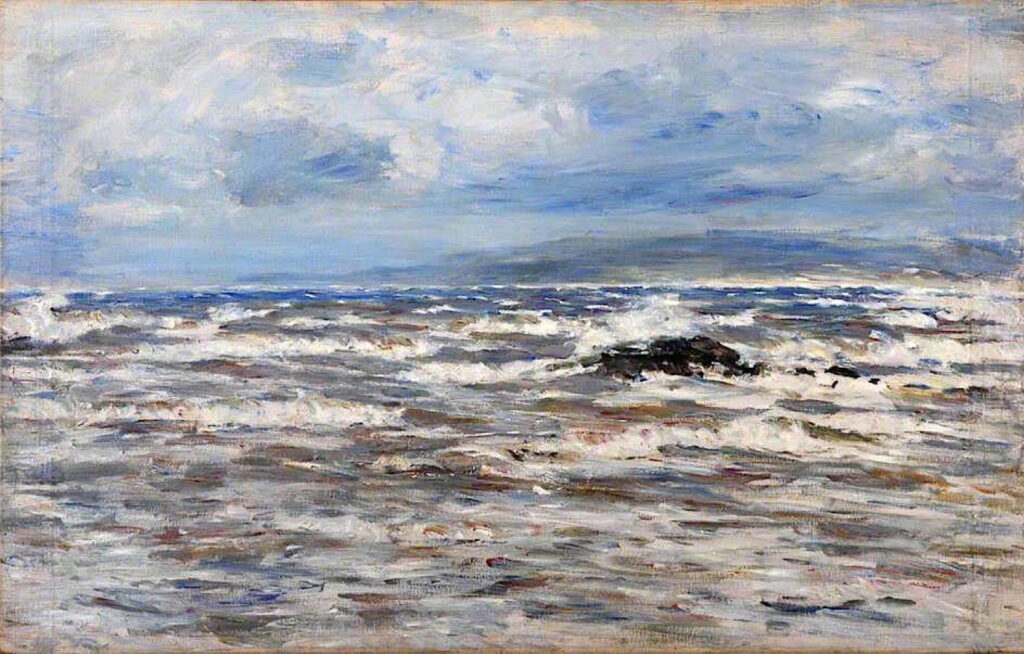On Scottish beaches with William McTaggart

If you’ve never visited a remote Scottish beach, now is the time to do so. To give you a taste of those in Kintyre, on the west coast, this article shows a small selection of the paintings of William McTaggart (1835–1910). I’m sure if you looked hard enough around his favourite haunts there, you’ll still find him painting briskly on another canvas.
He was born into a Scottish Gaelic-speaking family of crofters, in the tiny village of Aros, on the western side of the Kintyre peninsula. Like many of the best Scottish artists of the day, he studied at the Trustees’ Academy in Edinburgh, now the Edinburgh College of Art. He was very successful there, winning prizes, and started his career in figurative painting. After he was admitted as a full member of the Royal Scottish Academy (the Scottish sister organisation to the Royal Academy in London) in 1870, he turned to concentrate on painting the rugged west coast.
William McTaggart (1835–1910), Machrihanish Bay (1878), oil on canvas, 82.5 x 123.2 cm, National Galleries of Scotland (Presented by Mr and Mrs D W T Cargill 1938), Edinburgh, Scotland. Image by Antonia Reeve, courtesy of The National Galleries of Scotland, https://www.nationalgalleries.org/art-and-artists/5140/machrihanish-bay
Machrihanish Bay (1878) shows one of his favourite locations near his childhood home, on the west coast of Kintyre where it’s exposed to the full might of the North Atlantic Ocean. This bay is noted for its long unbroken stretch of sand, here being pounded by a moderate sea. His brushwork is far looser than in his earlier figurative paintings, and captures the variety of surfaces and textures.
William McTaggart (1835–1910), Summer Sundown – Tir-nan-og (1880), oil on canvas, 61 x 91.4 cm, The Tate Gallery (Bequeathed by Sir James and Lady Caw 1951), London. © The Tate Gallery and Photographic Rights © Tate (2016), CC-BY-NC-ND 3.0 (Unported), http://www.tate.org.uk/art/artworks/mctaggart-summer-sundown-tir-nan-og-n06044
During the summer, McTaggart stayed in the tiny fishing village of Machrihanish to capture its fleeting light conditions, as in his Summer Sundown – Tir-nan-og (1880). The name Tir-nan-og in its title refers to the legendary Celtic paradise in the west. McTaggart would almost certainly have been aware of the French Impressionists at this time, but probably didn’t see any of their paintings for another three years. Instead, it’s usually considered that he was influenced more by Whistler, the Hague School, and Joseph Israels in particular.
William McTaggart (1835–1910), Sun on the Waters, Fishing from the Rocks at Carradale (1882), oil on canvas, 76 x 102 cm, Private collection. The Athenaeum.
Sun on the Waters, Fishing from the Rocks at Carradale (1882) shows fine weather on the east coast of Kintyre, opposite the western coast of the Isle of Arran, which is just visible at the left edge. McTaggart often hired local children to model for his paintings, and these three appear to be taking great pleasure in their activity.
William McTaggart (1835–1910), Wind and Rain, Carradale (1883), oil on canvas, 74.9 x 106.1 cm, Dundee Art Galleries and Museums, Dundee, Scotland. The Athenaeum.
Even on the more sheltered side of Kintyre, squally showers can be frequent, as shown in Wind and Rain, Carradale from 1883.
William McTaggart (1835–1910), The Storm (1890), oil on canvas, 122 x 183 cm, National Galleries of Scotland, Edinburgh, Scotland. Wikimedia Commons.
The Storm (1890) shows the same area at the height of a severe gale, figures clad in sou’westers and clinging to the rocks as land, sea and air merge into one continuum. This painting was first purchased by the Scottish-American industrialist Andrew Carnegie.
Most of his larger paintings including this were made in his studio from smaller oil sketches made in front of the motif, following the classic process for landscape painting. Sometimes he and other Scottish landscape artists worked directly en plein air on large canvases, and there are photographs showing them doggedly painting the coast with their canvases lashed to the ground to prevent them from blowing away.
William McTaggart (1835–1910), Noontide, Jovie’s Neuk (1894), oil on canvas, 88.9 x 97.8 cm, City Art Centre, Edinburgh, Scotland. The Athenaeum.
Noontide, Jovie’s Neuk (1894) is a more peaceful scene at the northern end of Aberlady Bay, a picturesque section of coastline to the east of Edinburgh, on the east coast of Scotland.
William McTaggart (1835–1910), The Coming of Saint Columba (1895), oil on canvas, 131 x 206 cm, National Galleries of Scotland (Purchased 1911), Edinburgh, Scotland. Image by Antonia Reeve, courtesy of The National Galleries of Scotland, https://www.nationalgalleries.org/art-and-artists/5133/coming-saint-columba
McTaggart also set historical scenes into his coastal landscapes, here The Coming of Saint Columba from 1895. This Irish abbot and missionary is generally believed to have brought Christianity to Scotland around 563 CE. Although most strongly associated with the first abbey on the remote island of Iona, Columba initially crossed to Kintyre before travelling north. The artist chose The Gauldrons, a rocky bay west of Machrihanish, as the scene, and is believed to have painted the landscape en plein air, later completing the figures and boats back in the studio.
During the middle and latter part of the nineteenth century, large numbers of Scots from the Hebridean islands emigrated, many under duress, to America and Canada, in the hope that they would prosper there rather than starving on their crofts. McTaggart was deeply moved by these events, and his own sister and her husband were among those to emigrate. He painted three major works, and numerous copies and variants, marking the emigrations.
William McTaggart (1835–1910), The Emigrants Leaving the Hebrides (1883–89), oil on canvas, 94.6 x 141 cm, The Tate Gallery (Purchased 1931), London. © The Tate Gallery and Photographic Rights © Tate (2016), CC-BY-NC-ND 3.0 (Unported), http://www.tate.org.uk/art/artworks/mctaggart-the-emigrants-n04610
The Emigrants Leaving the Hebrides was started in 1883, when McTaggart painted the headland from which the emigrants left at Carradale, on the east side of Kintyre, but he didn’t complete its details until 1889. This shows migrants loading their few possessions into rowing boats in the foreground, then being rowed out to the waiting ship in the distance. He shows several influences here, particularly that of Constable in the sky and his scattered highlights. By this time he’s likely to have seen Impressionist paintings when they were exhibited in London in 1883, although this work shows little influence from the likes of Monet.
William McTaggart (1835–1910), The Sailing of the Emigrant Ship (1895), oil on canvas, 77 x 87.5 cm, National Galleries of Scotland (Presented by Sir James Lewis Caw and Lady Caw 1931), Edinburgh, Scotland. Image by Antonia Reeve, courtesy of The National Galleries of Scotland, https://www.nationalgalleries.org/art-and-artists/5138/sailing-emigrant-ship
The Sailing of the Emigrant Ship (1895) shows a later stage in the process, with the emigrants all aboard the ship which is now sailing off to cross the Atlantic. Left behind on the rocky coast are those who were too old and infirm to travel, and are now left without the support of their younger family members. McTaggart’s handling of the sky in particular is here much rougher and more vigorous, with just a glimpse of a fragment of a rainbow, symbolising the hopes of the emigrants.
William McTaggart (1835–1910), A Westerly Gale, Machrahanish (1897), oil on canvas, 130.6 x 205.5 cm, Campbeltown Museum, Campbeltown, Scotland. The Athenaeum.
A Westerly Gale, Machrahanish (1897) is another superb rendering of rough conditions in this bay on the west coast of Kintyre.
Scotland’s beaches are many and varied, and wonderfully depicted by William McTaggart.


